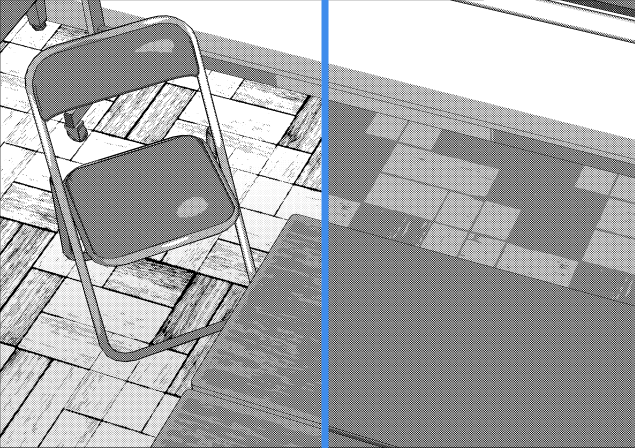2. Rough Draft
I’ll make a sketch first and then draw my draft on top.
[1] Creating the sketch
■1. Create a canvas for the sketch
I create a new canvas for the sketch from the [File] menu > [New].
I select the A4 canvas from the [Preset] dropdown menu, and then change the resolution to 72 dpi.
I find it easier to sketch my ideas roughly while looking at the overall picture when the canvas is small, so I reduced the resolution.
■2. Tools for sketching
For the sketch, I’ll use the [Pencil] tool → [Darker pencil] sub tool.
■ 3. Think of the whole image
I think about what I want to draw.
This time I wanted to draw something with themes of an amusement park, space, or a circus, so I use these themes as a base and roughly draw the elements as I imagine them.
While planning the overall layout, I consider how the image would look flipped, as well as the horizontal and vertical symmetry, so that the illustration will be fun to see from any angle.
[2] Making the rough draft
■1. Change image resolution
After I’ve finished my sketch, I go to the [Edit] menu > [Change Image Resolution] and increase the resolution from 72 dpi to 350 dpi.
I used a low resolution for the sketch, but the resolution should be higher for the rough draft so that the things I want to draw are clearer for the next line art stage.
■2. Change the color of the sketch
I change the color of the sketch so that it is easier to see the rough draft.
I select the sketch layer on the [Layer] palette and click the icon for [Lock Transparent Pixel] at the top of the palette.
Then, I use the [Edit] menu > [Fill] to fill the brown lines with light blue, and I lower the opacity of the layer.
Because [Lock Transparent Pixel] is on, only the lines are filled.
Hint: Changing layer colors in the [Layer Property] palette
You can change the [Layer color] of sketches and rough drafts by going to the [Layer property] palette > [Effect].
When you set a [Layer color], anything drawn on that layer will change to the color you choose.
If you set a layer color for a layer folder, you can change the color of all the layers in the folder simultaneously.
Note: Read the following article to learn more about layer colors.
■3. Decide the character design
For this illustration, I’ll decide the girl’s costume in advance, then draw it according to this design. I imagined her as a ballerina or dancer.
My characters are often anthropomorphic, but I create designs for the clothes that match the concept of the illustration.
[3] Rough draft
■1. Rough draft lines
I start drawing my rough draft while firming up the concept.
I split the rough lines into four layers: “rough character”, “items 1”, “items 2”, and “items 3”.
I use the [Pencil] tool → [Darker pencil] sub tool, the same as for the sketch.
I set the design of elements that I was uncertain of at the sketching stage, such as the clothes and some small items.
■2. Organizing the layers
After I’ve drawn the rough draft, I create a “rough draft” layer folder in the [Layer] palette and move the four draft layers into here.
I lock the pixels on each layer and fill with light blue, like for the sketch.
In order to make the line art stage easier, I then block off the sections with colors, so that the characters are light blue and the background is purple.
Now I’ve finished my rough draft.
























Comment